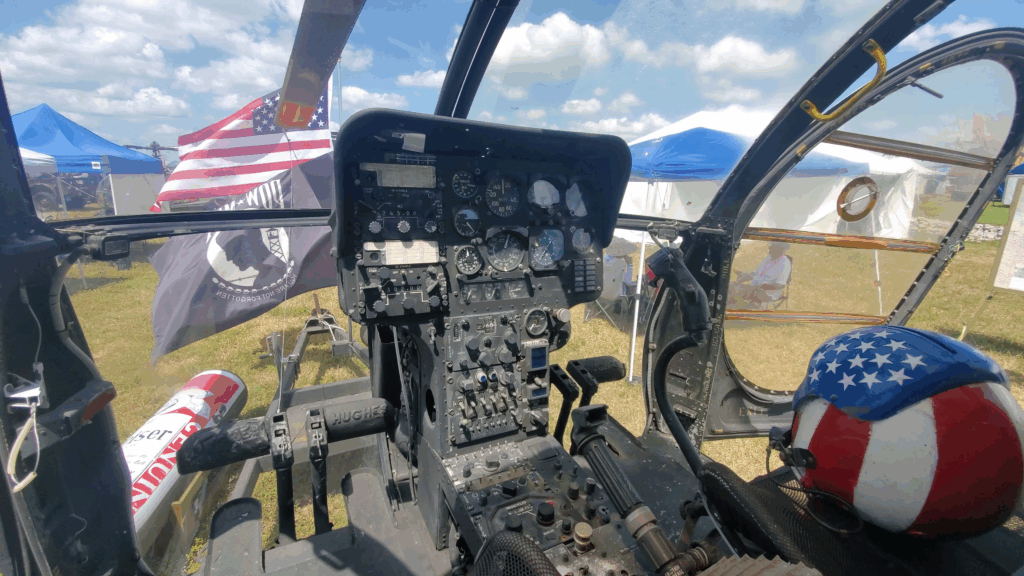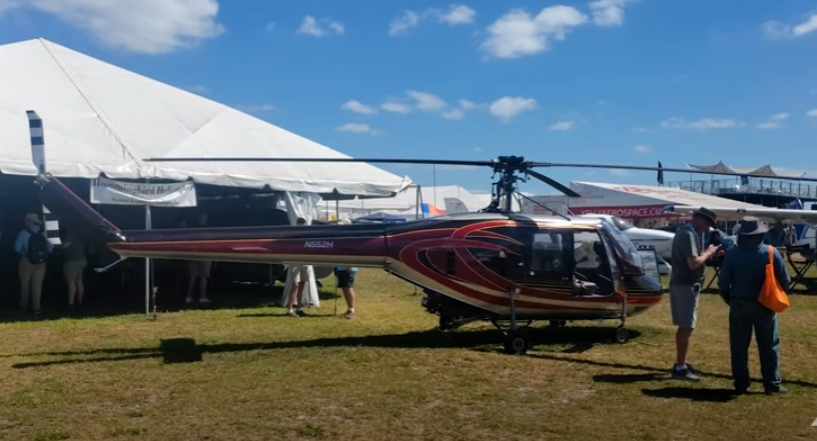By: Rex Alexander, AG Infrastructure Ambassador
At this year’s Sun ‘n Fun Airshow, held in Lakeland, Florida, I had the pleasure of speaking with numerous individuals representing the helicopter and vertical flight market. While Sun ‘n Fun has predominantly focused on the airplane industry in the past, this year, the helicopter and vertical flight community made their presence known. The following is just a sampling of some of the great stories I encountered throughout the week—from new designs and workforce development initiatives and to organizations that bring this community together. All in all, Sun ‘n Fun provided a fantastic experience filled with incredible stories from some of the most intriguing aviators in our industry. I highly recommend that you consider joining the fray next year.
Vertical Lift Design Upgrades That Stole the Show
Traditional Hummingbird Helicopter Gets UAV Makeover
Vertical Aviation Technologies (VAT), in collaboration with uncrewed aerial vehicle (UAV) manufacturer Apeiron, debuted their latest creation: a significant transformation of the traditional L300 Hummingbird helicopter into a fully autonomous UAV.
The L300 helicopter is a four-place, kit-built aircraft based on the FAA-certified S-52. It already supports a fairly high payload, with a maximum gross weight of 2,850 pounds and a useful load of 1,000 pounds.
In speaking with Dan Franco, Chief Operating Officer of Apeiron, he indicated that this new effort incorporates the already proven and FAA-certified design and rotor system of the original aircraft. The new system, which includes Apeiron’s NeuroHawk AI control system, and known as the MQ-52 Guardian, has expanded the aircraft’s useful load to upwards of 1,500 pounds. Franco said, “The project is specifically designed to support high-payload operations across the civil, commercial, and defense sectors.”
In developing their new UAV platform, the team is currently evaluating three engines: the LS7, Lycoming IO-540 and a Deltahawk diesel power plant. All three delivered excellent performance, achieving maximum airspeeds of around 110 mph, a climb rate near 950 feet per minute and a range of approximately 400 miles or 3.5 hours. Testing remains underway.
Improving on the (Crewed) Hummingbird Helicopter
While the Hummingbird helicopter has been around for several years, its developer, VAT, has never rested on its laurels. A significant milestone in VAT’s legacy is producing the first FAA-certified helicopter kit on the market. For their ongoing development efforts, they earned the “Best Helicopter” award at the previous expo.
Brad Clark, owner and president of VAT, noted that the 300L helicopter is now powered by a Lycoming IO-540 engine, equipped with cold air induction and an aerobatic sump. “It’s a really good engine that has worked out exceptionally well for us,” he remarked.
Some recent innovations in their product line include a newly completed all-electric air conditioning system, complete with computer-aided design (CAD) drawings and installation instructions for kit builders. Another notable update is the company’s new electric throttle governor, designed to maintain rotor RPM in the optimal range in turn reducing pilot workload.
One major issue Clark spoke passionately about was the growing difficulty in finding new talent in aviation. “It’s tough finding people,” he said. “Young mechanics with the gleam in their eyes that want to be here—we’re still struggling.
Robinson Helicopter Advances Latest Design
While at Sun ‘n Fun, I had the opportunity to sit down with David Smith, President and CEO of Robinson Helicopter, who provided an in-depth overview of their newest helicopter platform, the R-88.

According to Smith, the vision for the R-88 began with Frank Robinson several years ago, but was paused until they were confident they could see the project through to completion. Smith believes the R-88 is a helicopter the industry truly needs. Designed to be robust and accessible, the company built it to support a wide range of mission profiles across both the rotary-wing and fixed-wing markets globally to support almost any kind of mission to include EMS, Fire Fighting, Search and Rescue, and Law Enforcement.
Given that the flight controls are deeply integrated and the engine is governed by its own Full Authority Digital Engine Control (FADEC) system, extensive airworthiness checks are still required. “While software can be a great equalizer,” Smith explained, “it does present risks that must be thoroughly accounted for in testing.” He anticipates test flights as early as next year, with the goal of FAA certification by the end of the decade.
Several of Robinson’s clients have expressed an urgent need for the R-88 due to the high cost of operating many of the dominant helicopters in today’s market.
Inspiring the Next Generation of Vertical Lift Professionals
Helo Girls Book Series Brings Helicopters to Life for Young Readers
Transitioning from U.S. Army Warrant Officer and Black Hawk helicopter pilot to children’s book author may be unconventional, but Kodey Bogart proves that nothing is impossible. Joining the Army at 17, Bogart—who had the opportunity to take what’s known as a “morale flight” (flights offered to reward and motivate non-aviation personnel) early in her career—immediately fell in love with flying helicopters.

Driven by her newfound passion for aviation, Bogart soon became one of the first female Pilots in Command flying combat NVG (night vision goggle) operations in the Florida Army National Guard. Since then, she has established herself as an aviation entrepreneur as the Chief Executive Officer of KB Aviation Solutions, a company specializing in implementing and optimizing Safety Management Systems (SMS) in the helicopter industry.
Bogart’s passion for inspiring the next generation of aviators came from a gap she identified as a young mother—the lack of children’s books accurately portraying helicopters and the wide range of missions they perform. Thus, the series Helo Girls was born. It introduces young readers to the fascinating world of helicopters, all based on Bogart’s real-life experience.
Whether it’s air medical evacuation, aerial firefighting or law enforcement, the series takes young readers on an exciting ride into the world of helicopter aviation, told by someone who’s been there and done that.
“Street to Seat”: A Path to U.S. Army Aviation
While visiting the Army Aviation booth at the airshow, I had the pleasure of speaking with fellow helicopter pilot and Chief Warrant Officer Calvin Bigby. In my 40+ years in aviation, I’ve learned that every pilot’s path to the cockpit is a unique story, and Calvin’s was no exception.
Starting his career as a mechanic and CH-47 Chinook crew chief, it wasn’t long before Bigby aspired to move to the front seat. That aspiration led him to apply for the Army’s Warrant Officer and flight school program. Chief Bigby admitted the journey was challenging—or, as he put it, “like drinking from a fire hose—with tons of new information, constant studying, constant flying and learning a whole new system.” Still, having mastered all of it, he’s extremely proud of where he is today.
As for how he ended up flying the Apache rather than another Army platform, Bigby said that during his time as a crew chief, he worked alongside all the aircraft in the Army inventory, but fell in love with the Apache and its unique mission – low altitude, nap of the earth (NOE) day/night/night vision armed reconnaissance, close combat, and mobile strike operations. “I love doing what I’m doing,” Bigby stated. “I get to fly this aircraft.”
Bigby now works to inspire the next generation of aviators and encourages those interested in Army aviation to start sooner than he did. He specifically recommends the Army’s “Street to Seat” Warrant Officer Flight Training (WOFT) program, which provides civilians a direct path from Basic Training to flight school.
Vertical Lift Organizations Making a Difference
Who Is the Florida State Guard?
The Florida State Guard is not part of the National Guard or the Department of Defense. Reactivated in 2022, the Florida Guard is a component of the state-level Department of Military Affairs. Its primary mission is to support Florida-based humanitarian operations and disaster response efforts. The Guard is composed of four distinct sections: the Aviation Response Squadron, Crisis Response Battalion, Maritime Response Squadron, and the Special Missions Unit.
According to spokesperson Capt. Wes Dumey, the first initial entry training class, graduated in 2023. The unit now consists of approximately 800 members. As for aviation assets, Capt. Dumey stated that the unit operates two UH-60A helicopters, two Robinson helicopters, and some additional fixed-wing aircraft.
To join the Florida Guard, applicants must be Florida residents between the ages of 18 and 60. While prior military or law enforcement experience is beneficial, it is not required for consideration. However, the more certifications an applicant holds, the more opportunities they can pursue.
Vietnam Helicopter Pilots Association of Florida
One of the most memorable connections I made at this year’s Sun ‘n Fun was with the Vietnam Helicopter Pilots Association of Florida. Sitting down with Tom Tomlinson, a member and volunteer with the association for the past 18 years, I received a compelling history lesson about Army aviation and helicopter operations during the Vietnam War.

The association’s mission is to raise public awareness about Vietnam veterans and honor their service by telling their stories. They participate in various veteran-focused events throughout the year, including The Moving Wall, a half-scale replica of the Vietnam Veterans Memorial in Washington, D.C.
According to Tomlinson, the association does not have a centralized headquarters. Instead, its chapters are spread throughout the state based on where members reside. Originally started in the Tampa area, the association now has groups in Pensacola, Jacksonville, and Miami with a total of 293 members. Most members are life-timers and come from the ranks of veteran pilots, crew chiefs, and door gunners.
Tomlinson shared that, often, veterans who’ve never spoken about their service open up when they see the association’s display—particularly when they encounter a helicopter. For many, the aircraft was a central and emotional part of their experience, sparking long-buried memories.

